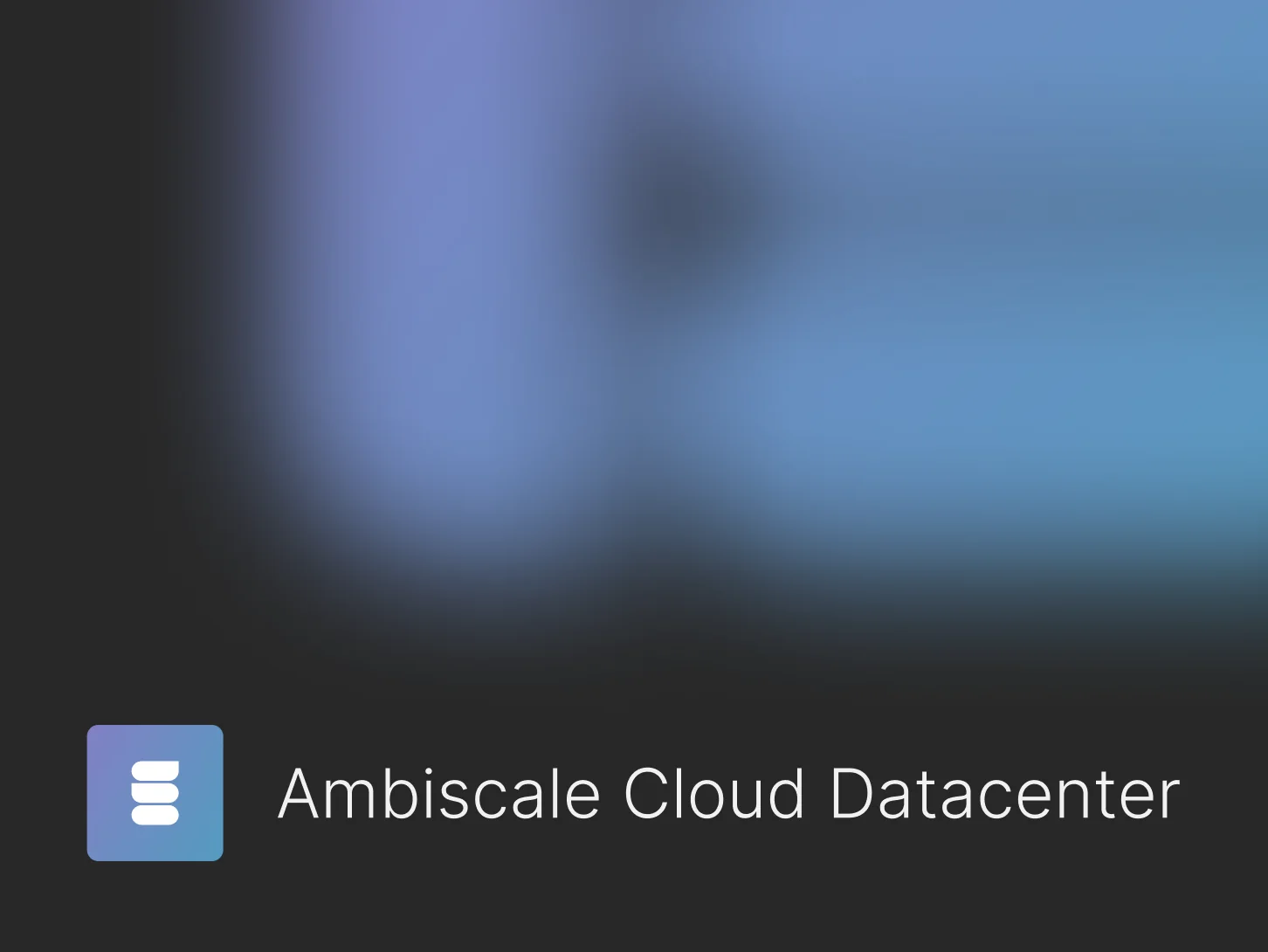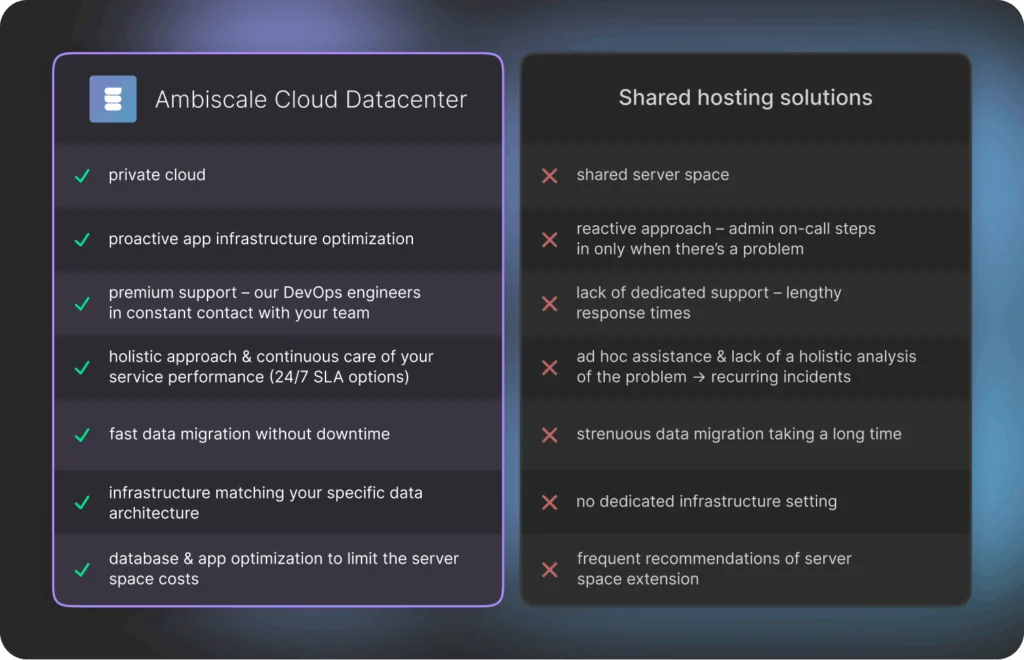When is it worth switching from shared hosting to a private cloud?

If you’re using shared hosting and considering a move to a private cloud, it’s worth taking a closer look at the real differences between these two models before making any decisions. Understanding the right moment to switch, knowing what the migration process involves, and being aware of the benefits you can expect afterward are all key to making the decision about the transition. In this article, we break down the signals that suggest it may be time to upgrade, outline what to expect during the migration itself, explore the advantages of moving to a private cloud, and examine how such a move can influence the long-term cost of ownership.
Private cloud vs shared hosting – key differences
1. Performance
Shared hosting is a bit like living in a crowded apartment building – when one tenant throws a loud party or overloads the shared utilities, everyone else feels the impact. Multiple websites run on the same machine, competing for system resources. If one “neighbor” experiences a traffic spike or runs resource-intensive scripts, your website can become sluggish or unresponsive. These performance fluctuations can be unacceptable for business-critical applications where consistency matters.
In a private cloud environment, you receive resources dedicated exclusively to your application – CPU, RAM, and storage are reserved for your workload alone. This means stable, predictable performance, even during periods of heavy traffic. Your application won’t slow down due to someone else’s activity, and you retain full control over how resources are allocated.
2. Scalability
With private cloud infrastructure, scaling up or down is almost effortless. You can add CPU, RAM, storage, or even new instances in real time without downtime. This allows your environment to evolve naturally alongside your business – no need for disruptive migrations or reconfiguration just because your traffic increased.
In shared hosting, scalability is limited to preset plans with fixed resource caps. Upgrading usually means switching to a more expensive plan or migrating to a different server altogether. If your application or traffic grows quickly, shared hosting becomes a bottleneck, forcing urgent and often complex moves to more advanced environments.
3. Reliability
Private clouds typically include redundancy and failover mechanisms by design. Data is replicated, infrastructure is built to withstand failures, and uptime guarantees are significantly higher. Even when hardware issues occur, the impact is minimized, and applications remain available thanks to built-in high-availability strategies.
Shared hosting operates on a much simpler reliability model. If the physical server fails, your website may go down until services are restored from backups. There are no dedicated failover systems, no automatic redundancies, and no advanced resilience mechanisms. This results in a higher risk of downtime – an issue that can directly affect business performance.
4. Security
As mentioned before, shared hosting relies on a multi-tenant architecture – meaning many users coexist in the same environment. That may affect not only site performance, but also its security. If another tenant’s account is compromised, there’s a risk the entire server could be affected. You also have limited control over firewall rules, intrusion detection, or advanced security configurations, making shared hosting less suitable for sensitive or regulated data.
Private cloud environments, on the other hand, offer full isolation from other users. You don’t share the operating system, processes, or file system with anyone else, reducing the attack surface significantly. This makes it easier to implement strong security policies, encryption standards, and compliance frameworks such as General Data Protection Regulation (GDPR) or Payment Card Industry Data Security Standard (PCI-DSS).
5. Customization & control
Private cloud solutions allow you to customize nearly every aspect of your environment. You can choose the operating system, install any software, configure performance optimizations, or fine-tune security settings. This flexibility is invaluable for complex applications, custom stacks, or specialized workloads.
Shared hosting offers very little control by comparison. Providers define which versions of PHP, databases, or modules are available. Custom packages or advanced server configurations are often not permitted. This can restrict how your application works or prevent you from implementing newer features that rely on modern tooling.
6. Support for modern applications
Private cloud infrastructure is built to support modern development practices. Containerization (Docker), orchestration (Kubernetes), microservices, CI/CD pipelines, and automated deployments all work seamlessly. You can design distributed systems, run staging environments, and integrate DevOps workflows without limitations.
Shared hosting environments simply aren’t designed for this. There’s no Docker, no orchestration layer, no support for CI/CD, and minimal access to system-level configuration. For teams working with contemporary tools or building scalable applications, shared hosting imposes severe constraints.
7. Cost
Shared hosting is one of the cheapest options available, which is why it’s popular for small websites and basic projects. But low cost comes with trade-offs: limited performance, lower reliability, weak scalability, and constraints that often lead to costly migrations once a project begins to grow.
Private cloud solutions come with higher costs, as you pay for dedicated resources, enhanced security, high availability, and scalability. Additional expenses may include storage, bandwidth, monitoring, or backup strategies. For businesses that rely heavily on digital operations, though, these are strategic investments that support stability and growth.
When you factor in the cost of potential downtime, the users lost due to slow website performance, and the expenses of migrations forced by growth, the price difference may turn out to be far less significant than it seems at first glance. Depending on:
- the pace of your business growth,
- your security requirements,
- and the level of service you’re receiving from your current hosting provider,
investing in a private cloud can easily pay for itself.
Keep in mind that comparing the overall costs isn’t only about the numbers on the price list. It’s also about the time you and your team spend dealing with limitations, the potential losses caused by slowdowns or outages, and the provider’s response time when an incident occurs.
8. Adequacy for the size of the project
For small websites, blogs, or simple landing pages, a private cloud is often excessive. These projects don’t require high scalability, custom infrastructure, or advanced security controls. In such cases, shared hosting can be more than sufficient while keeping the costs low.
However, once a project begins to grow: the number of users grows rapidly, multiplying the data to be processed – the limitations of shared hosting become apparent. At that moment, a private cloud becomes not just beneficial but necessary to maintain performance and reliability.
9. Migration complexity
Migrating to a private cloud may require detailed planning, environment configuration, and sometimes changes to the application itself. While the long-term benefits are significant, the process may involve temporary downtime or extra effort to ensure everything works smoothly.
Migrating from shared hosting can be especially challenging due to non-standard configurations or outdated environments. Projects that have grown organically on inexpensive hosting often need cleanup or refactoring before transitioning to a more advanced infrastructure.
10. Required technical expertise
Shared hosting has been designed for simplicity. The provider handles the system maintenance, and you interact with a user-friendly panel. This makes it ideal for individuals or small teams who need a functioning website without technical complexity.
With a private cloud, you gain powerful capabilities – but they require knowledge to use effectively. Managing updates, configuring services, monitoring performance, and ensuring security may require a sysadmin, DevOps engineer, or technology partner with cloud experience.
In Ambiscale Cloud Datacenter, we combine the power of private cloud with the expertise of our DevOps team, to provide our clients with a complex service and ultimate peace of mind.
Ambiscale Cloud Datacenter – more than a private cloud
We’ve got your back
In a traditional private cloud setup, you’re responsible for everything: updates, patches, service configuration, and monitoring. Ambiscale Cloud Datacenter takes that burden off your shoulders. Our DevOps team handles the migration, setup, full configuration, and continuous monitoring, allowing you to focus on the core of your business instead of firefighting performance issues or security vulnerabilities in your website or application.
Improved infrastructure = better server cost optimization
Your service or application is also optimized for the new hosting environment to reduce the amount of server space required. A shared hosting provider won’t look at your infrastructure holistically – which often leaves you exposed to recurring performance issues. You may be told that the solution is simply to buy more server space, but that’s rarely a reliable long-term fix. At th esame time, some of our clients have seen up to a 50% reduction in required server capacity after going through our infrastructure optimization process, along with a significant drop in the number of incidents.
Read more about what our clients gain by optimizing infrastructure
Priority support during incidents
With continuous optimization and ongoing improvements, our team prevents most incidents before they happen and minimizes the impact of those that do occur. Still, if an incident happens, two metrics matter most: RTO (Recovery Time Objective, i.e. how quickly your service must be restored) and RPO (Recovery Point Objective, ie. how much data you can afford to lose). You want your private cloud provider to react immediately, restore the service quickly, and keep any potential data loss to a minimum. With Ambiscale Cloud Datacenter, you receive priority support at all times, which eliminates the phase of nervous waiting for a response. Our DevOps engineers stay in constant contact with your tech team to make both day-to-day operations and incident recovery as smooth as possible.

So, when switching to a private cloud makes sense?
Switching is often worth it if:
- Your site or app is growing.
- You need high performance or guaranteed uptime.
- You want more control and flexibility.
- Security and compliance are important.
- You’re running modern or resource-intensive applications.
It might not be worth it if:
- You have a small, low-traffic site.
- You’re on a tight budget.
- You don’t want to deal with too much technical management.
What to pay attention to when switching to a private cloud
When choosing a private cloud provider, it’s important to look beyond the infrastructure itself and focus on a partner who truly understands the specifics of your business. Every application has its own performance patterns, integration points, and operational constraints, and these factors heavily influence how the environment should be designed.
A provider who takes the time to analyze your current setup and optimize the infrastructure during migration can significantly improve the stability and efficiency of your system. This level of understanding reduces unnecessary costs and ensures that the environment is prepared to scale in sync with your business.
Another key aspect is the quality of the migration process. Switching hosting environments can be stressful, especially when uptime directly affects revenue or user experience. A reliable provider will plan the migration carefully to keep downtime to an absolute minimum – or eliminate it entirely – using proven procedures, backups, and fallback strategies. Minimizing disruption during the transition is crucial, because even short periods of unavailability can lead to lost users, broken workflows, or damage to your brand’s reputation.
Finally, choose a partner who takes a holistic approach to your infrastructure and collaborates closely with your technical team. Preventing issues before they occur is far more valuable than fixing them after the fact, and that requires constant monitoring, optimization, and communication. When an incident does happen, immediate response is essential to protect your data and restore service as quickly as possible.
A provider who stays aligned with your developers and remains available at critical moments becomes an extension of your team – and that support can make a measurable difference in overall performance, reliability, and long-term peace of mind.


